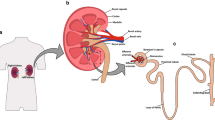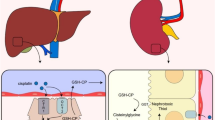Summary
The effects of cyclophosphamide (CPA) on the mouse (hr/hr strain) urinary bladder epithelium are described with regard to histology, proliferation (mitotic activity, LI, and cell number), and changes in ploidy.
An initial toxic effect on the epithelium was evident after injection of CPA, demonstrated by a focal cell loss of approximately 50% during the period from 10 to 24 h after the injection of CPA. The toxicity is partly direct and partly mediated through DNA replication, and leads to cell death and cell loss. The necrotic phase was followed by a rapid regeneration with normalization of the diploid and tetraploid cell populations in 2–4days. Prom 36 to 48 h the octoploid cell number increased by 3–4 times the normal number, and remained high for the rest of the observation period, with a maximum on the 5th day and a slight decrease during the following 2 weeks.
The labeling index (LI) was significantly decreased 2–4 h after administration of the drug and evidence of partial synchronization was seen. The LI started to increase at 12 h and reached a maximum at 36 h, after which there was a gradual decrease. With microflow fluorometry the increase in DNA synthesis was seen to appear initially in the diploid population, starting at 10 h, and then in the tetraploid population, at 24 h. The tetraploid DNA synthesis reached a maximal value of almost 7 times the normal one at 36 h.
An increased LI was followed by an increase in mitotic activity with a peak at 48 h and a gradual decrease during the first week. Diploid, tetraploid, and octoploid cells all underwent mitotic division.
The pattern of DNA synthesis in the different cell populations strongly suggests that the development of higher ploidies occurs mainly by repeated synthesis of DNA in the same cells, and not by fusion.
Cells of higher ploidy develop by repeated cycling of DNA along the vertical axis, and new cells within each ploidy population are formed by mitotic division and migration along the horizontal axis.
Similar content being viewed by others
References
Bellin, H. J., Cherry, J. M., Koss, L. D.: Effects of a single dose of cyclophosphamide. V. Protective effect of diversion of the urinary stream on dog bladder. Lab. Invest.30, 43–47 (1974)
Bierbauer, U.: Die Einwirkung der Cytostatica Endoxan und Trisaethyleniminobenzochinon auf das Knochenmark und perifere Blut der Ratte. Folia haemat. (Frankfurt)5, 143–161 (1961)
Blackett, N. M., Adams, K.: Cell proliferation and the action of cytotoxic agent on haemopoietic tissue. Brit. J. Haemat.23, 751–758 (1972)
Brown, C. H., Carbone, P.P.: Effects of chemotherapeutic agents on normal mouse bone marrow grown in vitro. Cancer Res.31, 185–190 (1971)
Bruce, W. R.: The action of chemotherapeutic agents at the cellular level and the effects of these agents on haematopoietic and lymphomatous tissue. Canad. Cancer Conf.7, 53–64 (1967)
Chaves, E.: Induction of bladder hyperplasia in rats after a single dose of cyclophosphamide. Rev. franç. Etud. clin. biol.13, 56–61 (1968)
Coggins, P. R., Ravdin, R. G., Eisman, S. H.: Clinical pharmacology and preliminary evaluation of cytoxan (cyclophosphamide). Cancer Chemother. Rep.3, 9–11 (1959)
Connors, T. A., Cox, P. J., Farmer, P. B., Foster, A. B., Jarman, M.: Some studies of the active intermediates formed in the microsomal metabolism of cyclophosphamide and isophosphamide. Biochem. Pharmacol.23, 115–129 (1974)
Cooper, E. H.: Cell proliferation in normal urothelium and urothelial tumours. In: P. Bucalossi, U. Vronesi N. Cascinelli (eds.), Proc. XI. Internat. Cancer Congress, Florence. Florence Vol. 1, p. 15–17. Amsterdam: Excerpta Medica 1975
Devik, F., Hagen, S.: Effects of x-rays and cytotoxic agents on the cell population of the crypts of the small intestine in mice. Virchows Arch. B Zellpath. 223–237 (1973)
DeWys, W. D., Goldin, A., Mantel, N.: Haematopoietic recovery after large doses of cyclo-phosphamide: Correlation of proliferative state with sensitivity. Cancer Res.30, 1692–1697 (1970)
DeWys, W. D., Kight, N.: Kinetics of cyclophosphamide damage—sublethal damage repair and cell-cycle-related sensitivity. J. nat. Cancer Inst.42, 155–163 (1969)
Farsund, T.: Preparation of bladder mucosa cells for micro-flow fluorometry. Virchows Arch. B Cell Path.16, 35–42 (1974)
Farsund, T.: Cell kinetics of mouse urinary bladder epithelium. I. Circadian and age variations in cell proliferation and nuclear DNA content. Virchows Arch. B Cell Path.18, 35–49 (1975)
Foley, G. E., Friedman, O. M., Drolet, B. P.: Studies on the mechanism of action of cytoxan. Evidence of activation in vivo and in vitro. Cancer Res.21, 57–63 (1961)
Forni, A.M., Koss, L. G., Geller, W.: Cytological study of the effect of cyclophosphamide on the epithelium of the urinary bladder in man. Cancer (Philad.)17, 1348–1355 (1964)
Friedman, O. M.: Recent biologic and chemical studies of cyclophosphamide (NSC-26271). Cancer Chemother. Rep.51, 327–333 (1967)
Fried, W., Johnson, C.: The effect of cyclophosphamide on haematopoietic stem cells. Radiat. Res.36, 512–527 (1968)
Hellman, S., Grate, H. E.: Effect of cyclophosphamide on the murine haematopoietic stem cell compartment as measured by different assay techniques. Blood38, 706–714 (1971)
Hicks, R. M.: The permeability of rat transitional epithelium. J. Cell Biol.28, 21–31 (1966)
Hicks, R. M.: The mammalian urinary bladder: an accommodating organ. Biol. Rev.50, 215–246 (1975)
Host, H.: Comparative effects of cyclophosphamide and total body irradiation on haemopoiesis in rats. Thesis. Universitetsforlaget, Oslo, Norway (1967)
Kaul, M., Hudson, G.: Effects of cyclophosphamide on the blood and bone marrow of the guinea-pig. J. Anat. (Lond.)104, 190 (1969)
Koss, L. G.: A light and electon microscopic study of the effects of a single dose of cyclophosphamide on various organs in the rat. I. The urinary bladder. Lab. Invest.16, 44–65 (1967)
Koss, L. G., Lavin, P.: Effects of a single dose of cyclophosphamide on various organs in the rat. II. Response of urinary bladder epithelium according to strain and sex. J. nat. Cancer Inst.44, 1195–1200 (1970)
Lane, M.: Some effects of cyclophosphamide (cytoxan) on normal mice and mice with L 1210 leukemia. J. Nat. Cancer Inst.23, 1347–1359 (1959)
LePecq, J.-B., Paoletti, C.: A flourescent complex between ethidium bromide and nucleic acids. Physical-chemical characterization. J. molec. Biol.27, 87–106 (1967)
Locher, G. W., Cooper, E. H.: Repair of rat urinary bladder epithelium following injury by cyclophosphamide. Invest. Urol.8, 116–123 (1970)
Martin, B. P.: Cell replacement and differentiation in transitional epithelium: a histological and autoradiographic study of the guinea-pig bladder and ureter. J. Anat. (Lond.)112, 433–455 (1972)
Philips, F. S., Sternberg, S. S., Cronin, A. P., Vidal, P. M.: Cyclophosphamide and urinary bladder toxicity. Cancer Res.21, 1577–1589 (1961)
Putten, L. M., van Lelieveld, P.: Factors determining cell killing by chemotherapeutic agents in vivo. I Cyclophosphamide. Europ. J. Cancer6, 313–321 (1970)
Schultz, M. E., Weldon, M. W.: Initial effects of cyclophosphamide on urinary bladder epithelium in the rat. Pathology6, 343–350 (1974)
Sisken, J. E., Kovacs, E., Kinosita, R.: Effects of cytoxan on DNA synthesis and the mitotic cycle in L 4946 mouse leukemia. Fed. Proc.19, 134 (1960)
Thaer, A. A.: Instrumentation for microfluorometry. In: G. L. Wied (ed.), Introduction to quantitative cytochemistry, pp. 409–426. New York: Academic Press 1966
Venditti, J. M., Humphreys, S. R., Goldin, A.: The effectiveness of cytoxan against mouse leukemia L 1210 and resistant sublines. Cancer Chemother. Rep.3, 6–8 (1959)
Author information
Authors and Affiliations
Rights and permissions
About this article
Cite this article
Farsund, T. Cell kinetics of mouse urinary bladder epithelium. Virchows Arch. B Cell Path. 21, 279–298 (1976). https://doi.org/10.1007/BF02899161
Received:
Issue Date:
DOI: https://doi.org/10.1007/BF02899161




